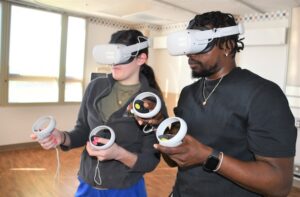FORT BRAGG, NC – A soldier lies bleeding on the ground with several injuries. Nurses rush onto the scene and in an effort to save his life, they begin pulling supplies from their medical kits. Fortunately, on this day the scenario is not real, but the lessons learned by it will be an invaluable tool they will carry with them throughout their careers.
“You wear a headset and hold controllers that track your hand movements”, describes Medical Simulator Operations Specialist, Don-Emeil Watson. “The simulation throws different casualty scenarios at you, like gunshot wounds, explosions, or even a mass casualty situation. You need to assess the situation, communicate with your virtual team, and provide life-saving medical aid using virtual tools and equipment that mimic real life.”
TC3, or Tactical Combat Casualty Care, represents established clinical protocols for managing combat injuries. VR training programs leverage these guidelines to create realistic battlefield simulations for medical personnel. The VR applications enhance learning by providing real-time patient progress data, enabled by motion tracking technology.
“Participants in the training will practice their clinical decision-making skills that they are not able to exercise all of the time in their daily work environment”, added Nancy Harnois, Certified Healthcare Simulation Educator at Womack. “Those skills diminish without use and in order to maintain readiness for whatever comes in the future we must ensure that our soldiers are maintaining and improving their skills.”
VR offers significant advantages in healthcare, including advanced medical training, better patient engagement and education, and innovative mental health therapies, all while reducing costs and improving patient outcomes. Secure, location-independent data access through connected services ensures only authorized personnel can access patient information.
Sgt. 1st Class Richard Layman, a Virtual Reality training leader at Womack says the training is particularly important to those working in a medical center. “When you get placed on assignment at a hospital, you don’t get a lot of field training”, Layman said. “If you get called to deploy, you’re going to go from a field hospital to a deployed environment without getting a lot of hands-on battlefield treatment. Everything we do in the hospital is very clinical oriented but with TC3 can practice the use of tourniquets and blast injuries, chest seals–a lot of stuff that we don’t usually do here in the hospital.”
Watson says the benefits of Virtual Reality training are numerous and they include:
• Mimicking Real-World Environments: VR can mimic diverse terrains, outside weather, warfare, and other environments.
• High-Risk, Low-Cost Training: Provides a place to practice dangerous procedures, complicated maneuvers, and engage with hostile forces without consequence.
• Repetition: Allows soldiers to repeat missions as many times as needed to perfect their skills and build muscle memory.
• Stress: Real combat is chaotic so VR can recreate that, forcing you to think clearly and act quickly under pressure.
• Practice: Repeatedly practicing these skills in a safe environment enhances muscle memory and confidence, so a trainee is not fumbling when lives are literally on the line.
• Learn From Mistakes: VR allows trainees to make mistakes and learn from them without consequences. Debriefings after each scenario helps to understand what worked and what could be improved.
“The Sim package we have is developed specifically for (and with) the military to allow practicing tactical combat casualty care skills wherever they are without the need for setting up multiple physical simulators,” added Harnois. “During the scenarios learners will work in teams to achieve the scenario objectives building their unit cohesion and having a little fun at the same time.”
“By the time a soldier faces a real casualty, they’ve ‘been there, done that’ multiple times in VR,” said Watson. “They’re familiar with the procedures, they can control their stress response, and they’re more likely to provide effective care quickly, which can be the difference between life and death on the battlefield. In essence, VR bridges the gap between classroom learning and real-world experience, creating better-prepared, more confident, and ultimately more effective lifesavers in the heat of combat.”
